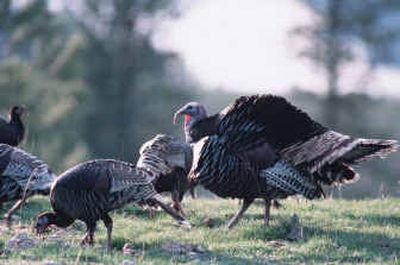Gobblers

Following yet another mild winter, the number of turkeys in the Inland Northwest has probably never been higher.
And with the 2005 spring turkey season more than half over, this may be the best time to call in a gobbler.
Several things have changed since the April 15 opening day in Idaho and Washington. Granted, the number of gobblers has been considerably reduced, but so has the number of hunters.
A friend of mine had a flock pegged as they went to roost the day before the opener, but apparently several other hunters did, too. After he had set up and taken a stand with his partner before daylight on opening morning, two hunters walked right through his decoys without hesitation.
Another hunter set up shop 40 yards below him and started calling, and calling, and calling.
“He never gave it a rest,” he said. “The turkeys came out of the roost and of course they went the other way. It was public land hunting at its worst.”
Even in areas where there’s no competition, bigger gobblers can be reluctant to come to a hunter’s call in the early season because they’re surrounded by flocks of hot hens that need attention.
If you don’t get the warier hens to come your way, the gobblers are likely to wander off the other direction with them no matter how much you plead on the slate call.
But now that most of the hens have been bred, more gobblers are looking for love in all the wrong places.
During late April, I was having difficulty getting a couple of noisy gobblers to come my way.
Last week, hunting in the same area north of Spokane, I was able to call in two lonesome gobblers from distant ridges on two separate occasions.
The toms had an uncanny ability to hone in on a few yelps from a quarter mile away and, with the urging of no more than a couple more soft clucks and purrs, they walked directly to my vicinity. And even though many serious hunters are working on filling their second tags, no other hunters were nearby to interfere.
Ten days seemed to make all the difference between an indifferent tom and a turkey dinner.
Meanwhile, the Washington Department of Fish and Wildlife is well aware that the state is in the glory days of turkey hunting. Wild turkeys have how been introduced into virtually every region of good turkey habitat, biologists say.
Except in areas that are too high or too thick with brush or timber, a hunter has a chance of finding turkeys at one time or another on virtually any ridge in northeastern Washington, the state’s hotbed for wild turkeys.
Turkey numbers are expanding in sage lands to the west of Spokane as well as the Spokane and Columbia river drainages and the Blue Mountains foothills and big-river canyons of southeastern Washington.
Many farmers who once protected turkeys as a novelty on their lowlands are now welcoming a few hunters to thin out the pests.
Turkeys are still trapped and relocated to relieve landowners from winter turkey infestations and to prevent turkey flocks from inbreeding. But the wildly successful program of relocating turkeys to new habitats was winding down in 2003 after 20 years, according to the first draft of a recently released WDFW turkey management plan.
Biologists say their emphasis is swinging from spreading the birds across the state to new concerns. Among them:
“Improving habitat to support all the exotic birds.
“Organizing winter surveys to get better information on where populations are too high.
“Trying to prevent diseases and parasites that have been known to devastate turkey flocks.
“Helping landowners cope with flocks big enough to raise havoc with crops and winter feeding operations.
With the number of turkeys and turkey hunters continuing to rise, the WDFW has released a plan to manage bird populations. The draft wild turkey management proposal that is available for public review and comment on the agency’s Web site at http://wdfw.wa.gov/wlm/game/water/turkey/management.
Comments on the plan will be accepted through Wednesday.